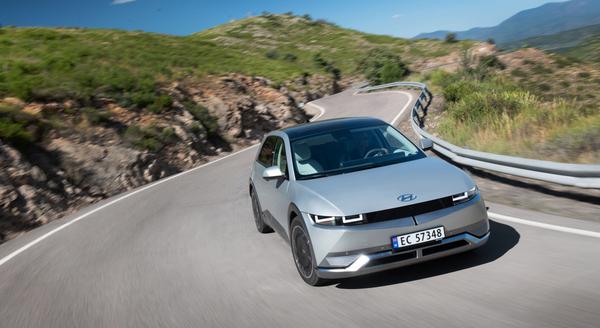Hyundai Ioniq 5 test: driving advice and autonomy measures
Here is a crazy love letter to Italdesign. Led by Giorgetto Giugiaro, the Turin firm experienced its most fertile period when the future was sketched with wedge shapes. Think, for example, of the thick C-pillar of the first Volkswagen Golf (1974), the billhook of the Lancia Delta I (1979), the sharp cut in the doors of the Fiat Panda (1980) or the twin headlamps squares of the DeLorean DMC-12 (1981)…
So many modernized stylistic references on this unexpected Ioniq 5, produced under the direction of Belgian designer Luc Donckerwolke, who worked for Lamborghini in particular. See the light signature in pixels, the lines crossing the sides or the wide and long smooth bonnet. This machine based on the e-GMP platform is innovative in its proportions. The measurements say SUV (4.64 m long, more than 1.60 m high), but the 20-inch wheels and the giant wheelbase of 3 meters give it a maxi-compact look.
Interior
Moreover, in the cabin, it is also XXL. First on the storage side. The door bins easily store a duo of large bottles of water when two gigantic units find their place on the sliding center console (with slot for induction telephone charging) or under the dashboard.
Very refined and giving off a lot of legroom, it revolves around two 12-inch screens arranged like in a Mercedes. But where Untertürkheim chose dummy speedometers, Hyundai opted for contemporary graphics. We would have appreciated a larger battery percentage indicator. The central touch screen is quick to use but complex to handle; it takes time to find the original menu. To bypass the Korean system, be aware that the set is compatible with Apple Car Play and Android Auto. The “techno” equipment on our Executive version could not be more generous: blind spot monitoring, lane keeping (too intrusive for our taste), remote parking, head-up display…
Elsewhere, the blends are above reproach. Partially made from the recycling of PVC bottles, the plastics are uneven. Enveloping and comfortable, the front seats are electrically reclining and equipped with removable calf supports. At the rear, space is more than generous in the knees. As is often the case with electric vehicles, the absence of a central tunnel counterbalances the very slight discomfort caused by the seats low in relation to the floor.
Little grief, trunk side. The presence of the rear electric motor also enhances the work plan, limiting the capacity to 527 litres. Fortunately, the 60/40 rear seat slides (electrically optional) to add more depth to the hold. Under the hood, a small space of 24 liters – 57 on the propulsion – will house charging cables and backpacks.
Conduct

Three power levels (170, 218 and 306 hp) and two battery sizes (58 and 72.6 kWh) are offered in the Hyundai catalog. The fastest version, which we try here, has two permanent magnet synchronous motors placed on each of the axles. Unlike the entry-level rear-wheel drive, this HTRAC-badged version sends its cumulative torque of 605 Nm to all four wheels. Even in the rain, traction is beyond reproach. But this is not a sport, despite a 0 to 100 km / h checked in 5.2 seconds. The linearity of the accelerations and the 2.2 tons of the machine temper its character.
The proportions of the Ioniq 5 are surprising.
The calibration of the damping is also oriented towards comfort. If it pumps slightly on uneven surfaces and takes a little roll in curves, the Ioniq 5 limits body movements much better than a Ford Mustang Mach-E. Unlike many electric vehicles, the steering offers real consistency and the brake pedal transmits a very natural feeling. Thanks to the Korean test pilots for their work. Another benefit of these tests: the presence of paddles behind the steering wheel also makes it possible to adjust the regeneration in an instant. In urban areas, the wheelbase of 3 meters has a cost: the turning circle borders on 12 meters, making maneuvers difficult in small arteries. Fortunately, the reversing camera offers a very good definition and an appreciable panoramic view.
Autonomy
On the highway, our notebook is covered with other positive indications: equipped with double glazing, the Ioniq 5 benefits from good soundproofing. If the aerodynamic eddies remain perceptible by the ears, the passengers are excellently isolated from rolling noise. The directional stability is very good, despite a very strong side wind during our test. Some figures displayed on the instrumentation are less encouraging: at 130 km / h, the Korean borders on 24 kWh per 100 km, limiting the range to 300 terminals. On the road and in the city, our average was 22 kWh/100 km. Light feet will probably be able to go below the 19 mark, bringing the real autonomy to 350 km. Rather disappointing figures compared to the competition, Tesla and Ford in the lead.
The drag coefficient of 0.288 – compared to 0.25 for a Model Y – and the choice of a smaller battery than in the blue oval explain the passable position of the Ioniq 5. In addition, our test vehicle is equipped with 20-inch rims (option at 400 euros), cutting off about twenty terminals before each passage to the socket. A fit “in 19” will reduce the jolts on degraded road surfaces, will reduce the bill on the tire side… and the number of immobilizations. Now you know the price of elegance.
Refill
Hyundai has decided to reassure us on this chapter by equipping its vehicle with an 800-volt system, like the Porsche Taycan. This makes it possible to reach a peak charging power of 235 kW. A visit to an Ionity motorway terminal – Hyundai-Kia is part of this joint venture installing charging points throughout Europe – verifies the brand's claims. In 20 minutes and a coffee, we went up the gauge from 22 to 85%. But this is not free. In addition to a "big roller" subscription at 13 euros per month (free for the first year if you buy the Ioniq 5), you will pay 29 cents per minute of connection to this network. Either 5.80 euros for a recharge similar to ours or 10.40 euros (52 cents every 60 seconds) if you choose the least expensive formula at 4.50 euros/month. On a classic 11 kW terminal, recharging will be much slower: allow around 7 hours to go from 0 to 100% in your car park and more than a day on a 220 volt household socket.
The charging socket (Type 2 and Combo CCS) is located at the rear right of the vehicle.
And since we are talking about portfolio, the prices charged by Hyundai are close to the competition. Our top-of-the-range version just barely benefits from a bonus of 2,000 euros, going down to 57,900 euros. The Tesla Model Y Grande Autonomie, with greater range but less wahoo look, will be charged almost the same price. A few weeks before the first deliveries of the American, Hyundai is positioned as close as possible to Tesla. The design could make the difference.
Notice
Vast, comfortable, modern, the Ioniq 5 is much more than a beautiful design. We only regret an average range between two connections.
WE love :
We like less:
Price
Hyundai Ioniq 5 HTRAC Executive
Average manufacturer consumption / during the test (kWh / 100 km): 19 / 22 CO2 (g) / bonus: 0 / 2,000 € Fiscal power: 5 CV Country of manufacture: South Korea (Ulsan)
Range offered:
Electric from 58 to 73 kWh, from 170 to 306 hp, from 43,800 to 59,900 €
Technical sheet
Conduct
Engine: synchronous electric motors with permanent magnets, 95 bhp (rear) and 211 bhp (rear) Transmission: all-wheel drive, 1 gear + reverse gear Battery: lithium-ion polymer, 72.6 kWh Cumulative power (hp): 306 Torque (Nm ): 605 Average manufacturer autonomy / during the test (km): 430 / 310 Weight (kg): 2,095 to 2,175 kg Length x width x height. (m): 4.64 x 1.89 x 1.61 Wheelbase (m): 3.00 Charging time: 18 minutes from 10 to 80% (350 kW fast charging station), 7 hours from 0 to 100% (wallbox 11 kW), 31 hours (220 V domestic socket) Maximum speed (km/h): 185 km/h 0 to 100 km/h (s): 5.2 Standard tyres: 235/55 R19 Test tires : 245/45 R20 (Michelin Pilot Sport EV)
Live
5/2 chest (l): 527 / 1587
Recommended options
Main competitors
To read on auto-moto.com:
Our test of the Hyundai i20 N
Driving the Hyundai Bayon
All Hyundai news








